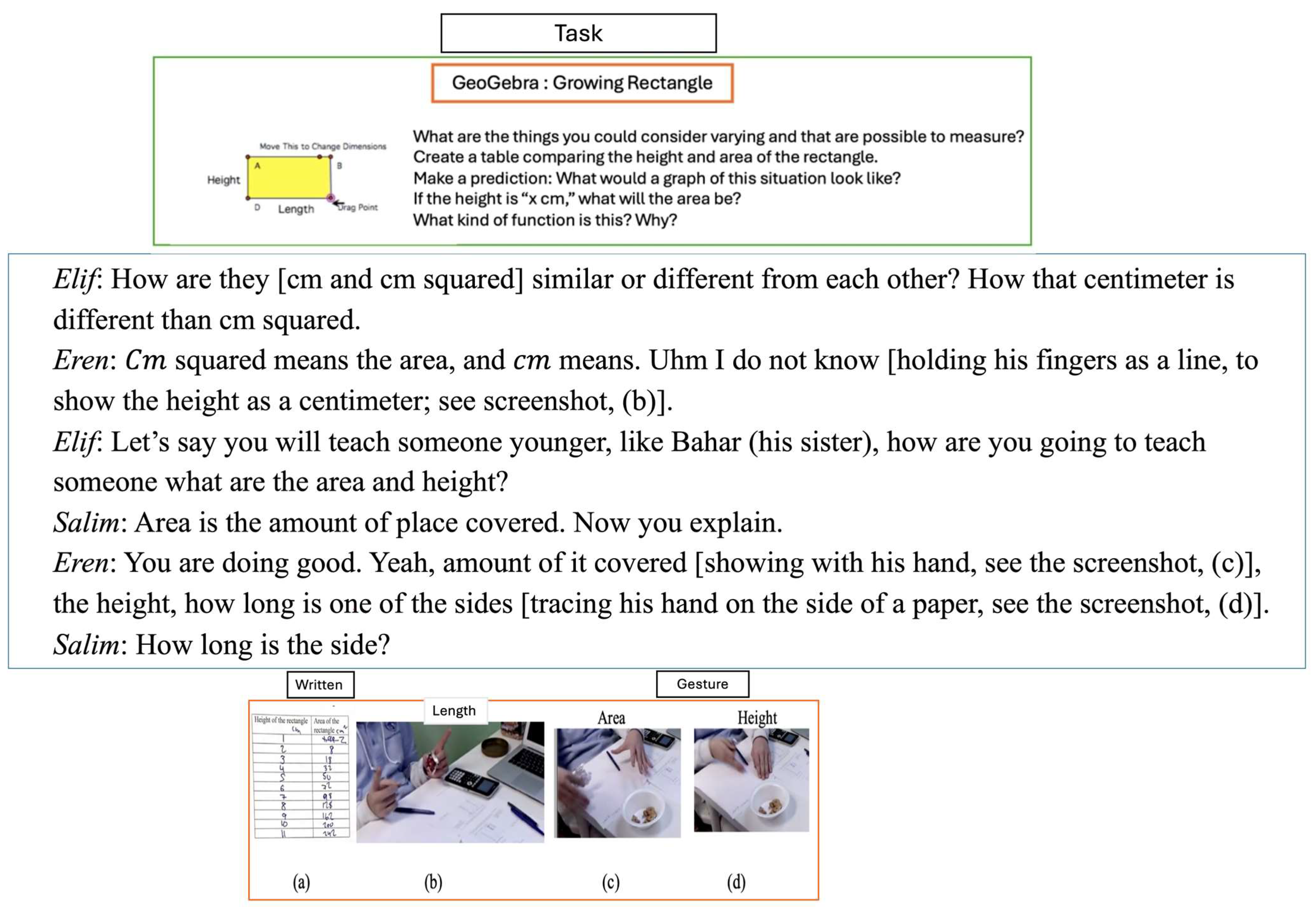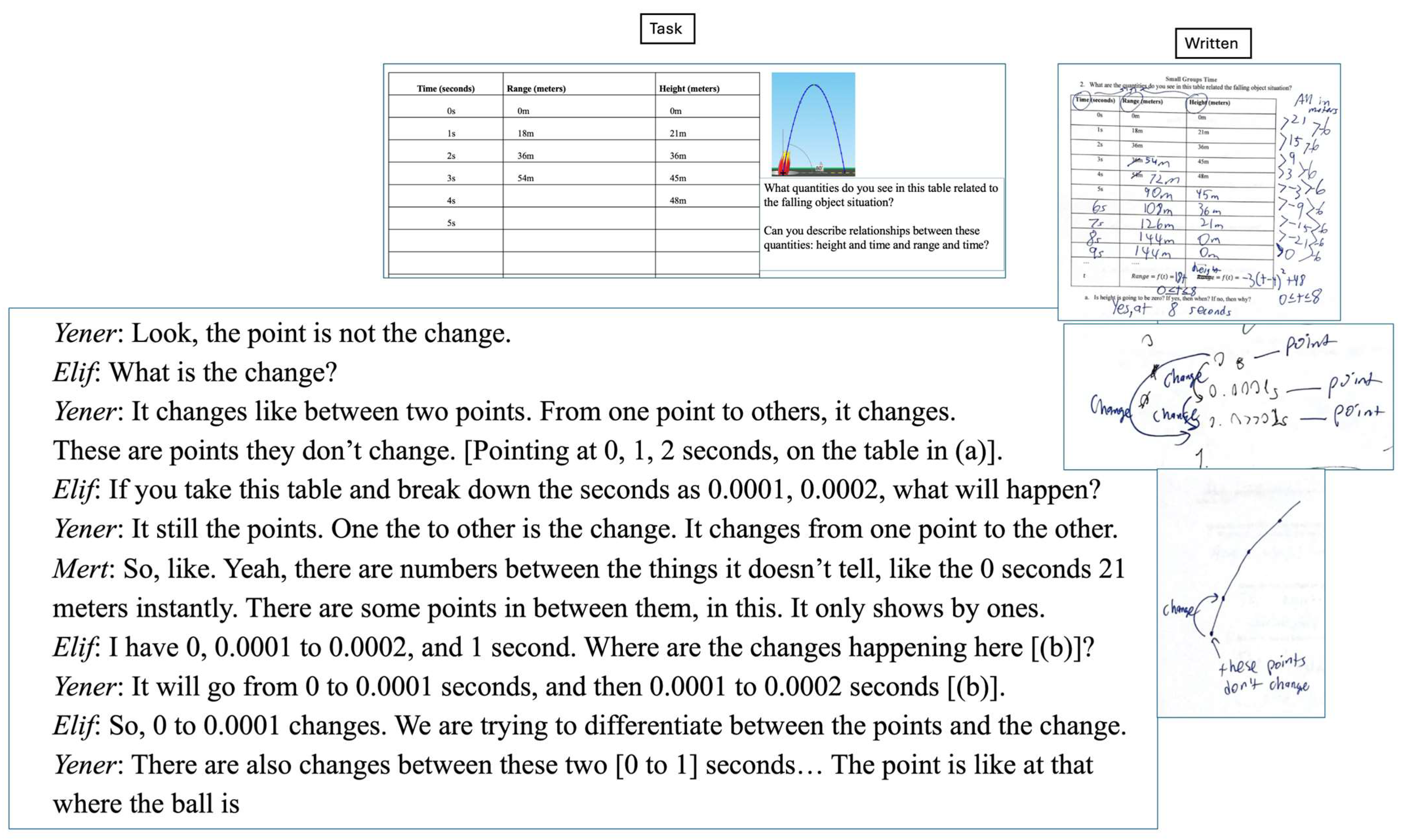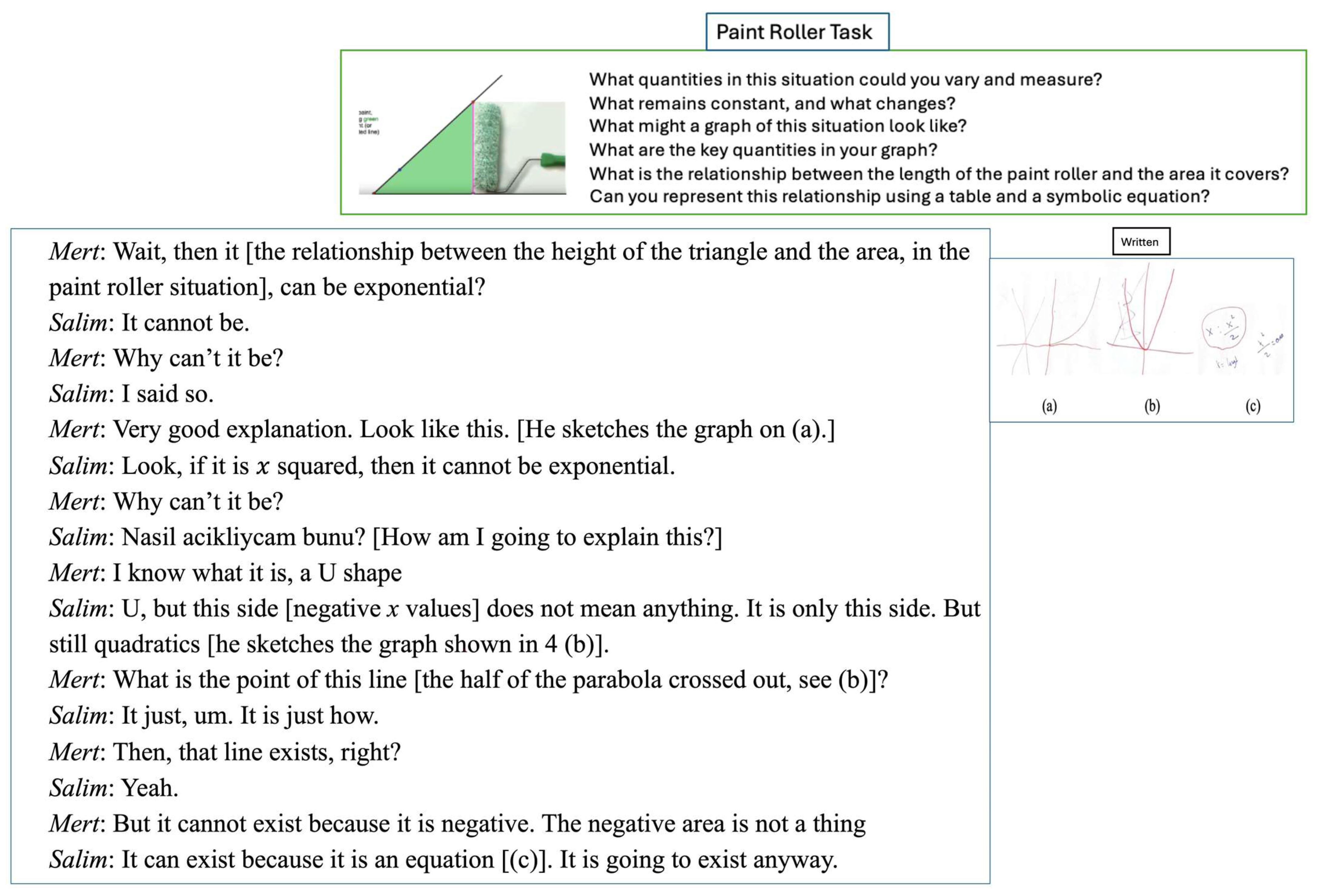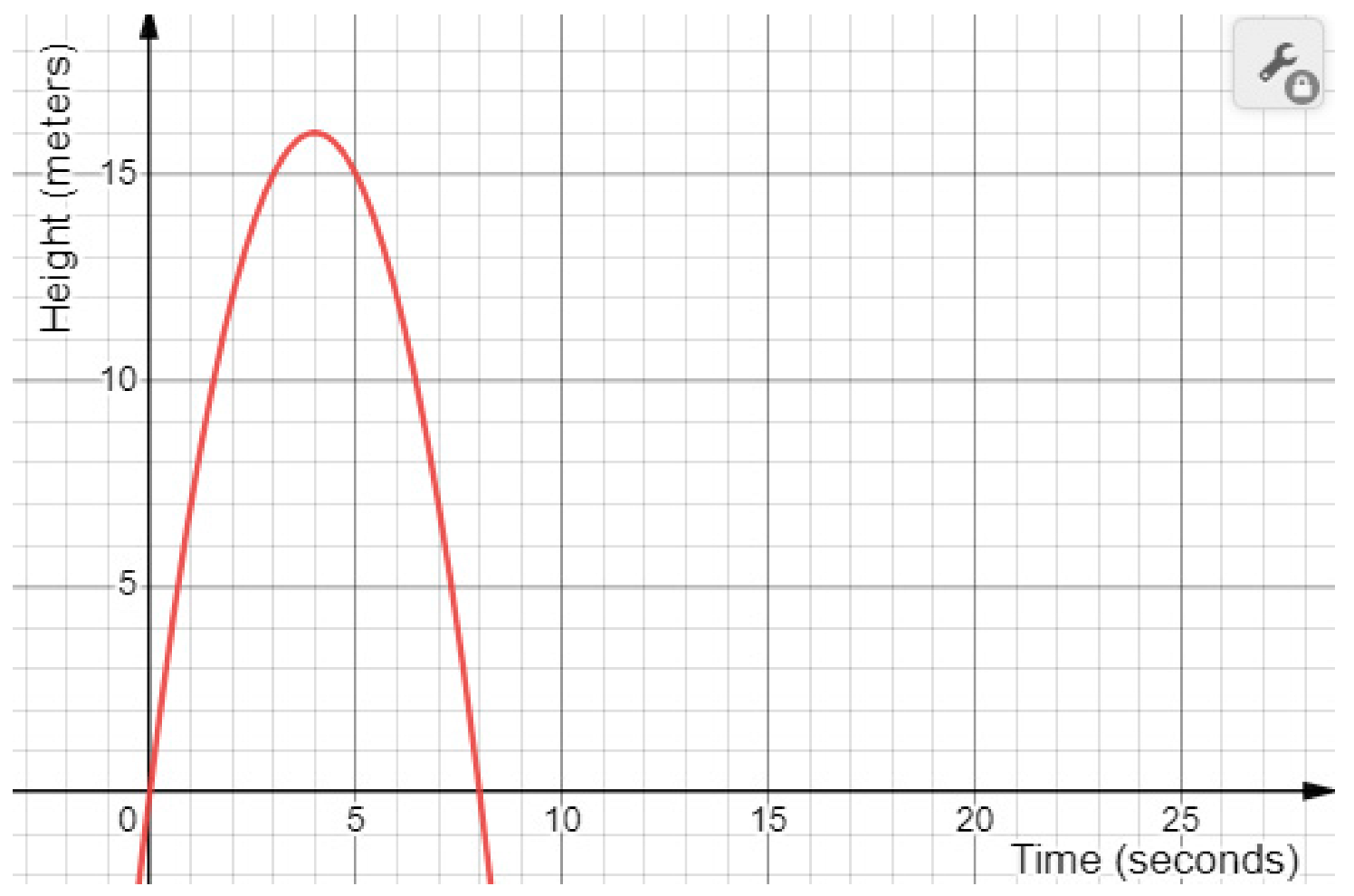A Culturally Inclusive Mathematics Learning Environment Framework: Supporting Students’ Representational Fluency and Covariational Reasoning
Abstract
1. Introduction
2. Literature Review
2.1. Representational Fluency
2.2. Covariational Reasoning
2.3. Co-Development of CR and RF
3. Conceptual Framework
3.1. Characteristics of Culturally Inclusive Mathematics Learning Environments
3.2. Position Students as Autonomous
3.3. Collaborative Social Interactions Within Classroom Culture
3.4. Norms
3.5. Teacher–Student Caring Relationships
4. Method
4.1. Research Design
Design of Instructional Supports
4.2. Experimenting
4.2.1. Episodes, Location, and Participants
4.2.2. First Author Positionalities and Reflexivity
4.2.3. Ongoing Analysis
4.3. Retrospective Analyses
5. Results
5.1. Prompting Students to Choose Units for Measuring Quantities
5.2. Shrinking and Enlarging Portions of Quantitative Magnitudes
5.3. Comparison Between Graphs of Quadratic and Exponential Functions
5.4. Creating and Connecting Representations to Present Quantitative Relationships
5.5. Summary
6. Discussion
6.1. Co-Development of CR and RF
6.2. Community-Based Practices
6.2.1. Teacher–Student Caring Relationship
6.2.2. Community Structures and Cross-Age Collaboration
6.2.3. Translanguaging as a Cultural Resource
6.3. Concluding Remarks
Author Contributions
Funding
Institutional Review Board Statement
Informed Consent Statement
Data Availability Statement
Conflicts of Interest
References
- Adu-Gyamfi, K., Stiff, L. V., & Bossé, M. J. (2012). Lost in translation: Examining translation errors associated with mathematical representations. School Science and Mathematics, 112(3), 159–170. [Google Scholar] [CrossRef]
- Altindis, N. (2021). Exploring The nature of The co-emergence of students’ representational fluency and functional thinking [Doctoral dissertation, Syracuse University]. [Google Scholar]
- Altindis, N. (2025). Networking theories of quantitative reasoning and mathematical reasoning to explore students’ understanding of functions. The Journal of Mathematical Behavior, 80, 101276. [Google Scholar] [CrossRef]
- Altindis, N., Bowe, K. A., Couch, B., Bauer, C. F., & Aikens, M. (2024). Exploring the role of disciplinary knowledge in students’ covariational reasoning during graphical interpretation. International Journal of STEM Education, 11(1), 32. [Google Scholar] [CrossRef]
- Altindis, N., & Fonger, L. N. (2019, November 14–17). Seeing exponential function despite representational fluency in a quantitatively rich quadratic function task [Research report]. The Forty-First Annual Meeting of the North American Chapter of the International Group for the Psychology of Mathematics Education, St Louis, MO, USA. [Google Scholar]
- Averill, R., Anderson, D., Easton, H., Te Maro, P., Smith, D., & Hynds, A. (2009). Culturally responsive teaching of mathematics: Three models from linked studies. Journal for Research in Mathematics Education, 40(2), 157–186. [Google Scholar]
- Bartell, T. (2011). Caring, race, culture, and power: A research synthesis toward supporting mathematics teachers in caring with awareness. Journal of Urban Mathematics Education, 4(1), 50–74. [Google Scholar] [CrossRef]
- Battey, D. (2013). “Good” mathematics teaching for students of color and those in poverty: The importance of relational interactions within instruction. Educational Studies in Mathematics, 82(1), 125–144. [Google Scholar] [CrossRef]
- Bieda, K. N., & Nathan, M. J. (2009). Representational disfluency in algebra: Evidence from student gestures and speech. ZDM, 41, 637–650. [Google Scholar] [CrossRef]
- Blanton, M., Stephens, A., Knuth, E., Gardiner, A. M., Isler, I., & Kim, J. S. (2015). The development of children’s algebraic thinking: The impact of a comprehensive early algebra intervention in third grade. Journal for Research in Mathematics Education, 46(1), 39–87. [Google Scholar] [CrossRef]
- Boaler, J. (2000). Exploring situated insights into research and learning. Journal for Research in Mathematics Education, 31(1), 113–119. [Google Scholar] [CrossRef]
- Bowers, J., Cobb, P., & McClain, K. (1999). The evolution of mathematical practices: A case study. Cognition and Instruction, 17(1), 25–66. [Google Scholar] [CrossRef]
- Brown, A. L. (1992). Design experiments: Theoretical and methodological challenges in creating complex interventions in classroom settings. Journal of the Learning Sciences, 2(2), 141–178. [Google Scholar] [CrossRef]
- Brown, A. L., & Campione, J. C. (1996). Psychological theory and the design of innovative learning environments: On procedures, principles, and systems. Lawrence Erlbaum Associates, Inc. [Google Scholar]
- Campbell, J. L., Quincy, C., Osserman, J., & Pedersen, O. K. (2013). Coding in-depth semistructured interviews: Problems of unitization and intercoder reliability and agreement. Sociological Methods & Research, 42(3), 294–320. [Google Scholar] [CrossRef]
- Carlson, M., Jacobs, S., Coe, E., Larsen, S., & Hsu, E. (2002). Applying covariational reasoning while modeling dynamic events: A framework and a study. Journal for Research in Mathematics Education, 33(5), 352–378. [Google Scholar] [CrossRef]
- Castillo-Garsow, C. (2012). Continuous quantitative reasoning. In L. L. Hatfield, & R. Mayes (Eds.), WISDOMe monograph: Vol. 2. Quantitative reasoning and mathematical modeling: A driver for STEM integrated education and teaching in context (pp. 55–73). University of Wyoming. [Google Scholar]
- Chitera, N. (2009). Code-switching in a college mathematics classroom. International Journal of Multilingualism, 6(4), 426–442. [Google Scholar] [CrossRef]
- Civil, M. (2002). Chapter 4: Everyday mathematics, mathematicians’ mathematics, and school mathematics: Can we bring them together? Journal for Research in Mathematics Education. Monograph, 11, 40–62. [Google Scholar] [CrossRef]
- Cobb, P. (2000). Conducting teaching experiments in collaboration with teachers. In A. E. Kelly, & R. A. Lesh (Eds.), Handbook of research design in mathematics and science education (pp. 307–333). Lawrence Erlbaum Associates. [Google Scholar]
- Cobb, P., Confrey, J., diSessa, A., Lehrer, R., & Schauble, L. (2003). Design experiments in educational research. Educational Researcher, 32(1), 9–13. [Google Scholar] [CrossRef]
- Cobb, P., Gresalfi, M., & Hodge, L. L. (2009). An interpretive scheme for analyzing the identities that students develop in mathematics classrooms. Journal for Research in Mathematics Education, 40(1), 40–68. [Google Scholar] [CrossRef]
- Cobb, P., Jackson, K., & Dunlap, C. (2017). Conducting design studies to investigate and support mathematics students’ and teachers’ learning. In J. Cai (Ed.), First compendium for research in mathematics education (pp. 208–233). National Council of Teachers of Mathematics. [Google Scholar]
- Cobb, P., & Whitenack, J. W. (1996). A method for conducting longitudinal analyses of classroom video recordings and transcripts. Educational Studies in Mathematics, 30(3), 213–228. [Google Scholar] [CrossRef]
- Cobb, P., & Yackel, E. (1996). Constructivist, emergent, and sociocultural perspectives in the context of developmental research. Educational Psychologist, 31(3/4), 175–190. [Google Scholar]
- Confrey, J., & Smith, E. (1995). Splitting, covariation, and their role in the development of exponential functions. Journal for Research in Mathematics Education, 26(1), 66–86. [Google Scholar] [CrossRef]
- Cornelius, L. L., & Herrenkohl, L. R. (2004). Power in the classroom: How the classroom environment shapes students’ relationships with each other and with concepts. In Investigating participant structures in the context of science instruction (pp. 467–498). Routledge. [Google Scholar] [CrossRef]
- DeJarnette, A. F., & González, G. (2015). Positioning during group work on a novel task in Algebra II. Journal for Research in Mathematics Education, 46(4), 378–422. [Google Scholar] [CrossRef]
- Dreyfus, T. (2002). Advanced mathematical thinking processes. In D. Tall (Ed.), Advanced mathematical thinking (pp. 25–41). Springer. [Google Scholar]
- Dreyfus, T., & Halevi, T. (1991). QuadFun—A case study of pupil computer interaction. Journal of Computers in Mathematics and Science Teaching, 10(2), 43–48. [Google Scholar]
- Ellis, A., Ely, R., Singleton, B., & Tasova, H. (2020). Scaling-continuous variation: Supporting students’ algebraic reasoning. Educational Studies in Mathematics, 104(1), 87–103. [Google Scholar] [CrossRef]
- Ellis, A. B., & Grinstead, P. (2008). Hidden lessons: How a focus on slope-like properties of quadratic functions encouraged unexpected generalizations. The Journal of Mathematical Behavior, 27(4), 277–296. [Google Scholar] [CrossRef]
- Esmonde, I. (2009). Ideas and identities: Supporting equity in cooperative mathematics learning. Review of Educational Research, 79(2), 1008–1043. [Google Scholar] [CrossRef]
- Even, R. (1998). Factors involved in linking representations of functions. The Journal of Mathematical Behavior, 17(1), 105–121. [Google Scholar] [CrossRef]
- Ferrari-Escolá, M., Martínez-Sierra, G., & Méndez-Guevara, M. E. M. (2016). “Multiply by adding”: Development of logarithmic-exponential covariational reasoning in high school students. The Journal of Mathematical Behavior, 42, 92–108. [Google Scholar] [CrossRef]
- Fonger, L. N. (2019). Meaningfulness in representational fluency: An analytic lens for students’ creations, interpretations, and connections. The Journal of Mathematical Behavior, 54, 100678. [Google Scholar] [CrossRef]
- Fonger, L. N., & Altindis, N. (2019, November 14–17). Meaningful learning; networking theories of multiple representations and quantitative reasoning [Research report]. The Forty-First Annual Meeting of the North American Chapter of the International Group for the Psychology of Mathematics Education, St Louis, MO, USA. [Google Scholar]
- Fonger, N. L., Ellis, A. B., & Dogan, M. F. (2020). A quadratic growth learning trajectory. The Journal of Mathematical Behavior, 59, 100795. [Google Scholar] [CrossRef]
- Glaser, B., & Straus, A. (1999). Discovery of grounded theory. Aldine Transaction. (Original work published 1967). [Google Scholar]
- Gutiérrez, R. (2002). Enabling the practice of mathematics teachers in context: Toward a new equity research agenda. Mathematical Thinking and Learning, 4(2–3), 145–187. [Google Scholar] [CrossRef]
- Hackenberg, A. J. (2010). Mathematical caring relations in action. Journal for Research in Mathematics Education, 41(3), 236–273. [Google Scholar] [CrossRef]
- Hesse-Biber, S. N., & Piatelli, D. (2007). Holistic reflexivity: The feminist practice of reflexivity. In S. N. Hesse-Biber, & D. Piatelli (Eds.), Handbook of feminist research: Theory and praxis. Sage. [Google Scholar]
- Hitt, F. (1998). Difficulties in the articulation of different representations linked to the concept of function. The Journal of Mathematical Behavior, 17(1), 123–134. [Google Scholar] [CrossRef]
- Johnson, H. L. (2012). Reasoning about variation in the intensity of change in covarying quantities involved in rate of change. Journal of Mathematical Behavior, 31, 313–330. [Google Scholar] [CrossRef]
- Kaput, J. J. (1987a). Representation systems and mathematics. In C. Janvier (Ed.), Problems of representations in the teaching and learning of mathematics (pp. 19–27). Lawrence Erlbaum Associates. [Google Scholar]
- Kaput, J. J. (1987b). Towards a theory of symbol use in mathematics. In C. Janvier (Ed.), Problems of representations in the teaching and learning of mathematics (pp. 159–197). Lawrence Erlbaum Associates. [Google Scholar]
- Ladson-Billings, G. (1995). Toward a theory of culturally relevant pedagogy. American Educational Research Journal, 32(3), 465–491. [Google Scholar] [CrossRef]
- Lobato, J. (2012). The actor-oriented transfer perspective and its contributions to educational research and practice. Educational Psychologist, 47(3), 232–247. [Google Scholar] [CrossRef]
- Moore, K. C. (2010). The role of quantitative reasoning in precalculus students learning central concepts of trigonometry [Unpublished doctoral dissertation, Arizona State University]. [Google Scholar]
- Moore, K. C., & Carlson, M. P. (2012). Students’ images of problem contexts when solving applied problems. The Journal of Mathematical Behavior, 31(1), 48–59. [Google Scholar] [CrossRef]
- Moore, K. C., Paoletti, T., & Musgrave, S. (2013). Covariational reasoning and invariance among coordinate systems. The Journal of Mathematical Behavior, 32(3), 461–473. [Google Scholar] [CrossRef]
- Moore, K. C., & Thompson, P. W. (2015). Shape thinking and students’ graphing activity. In O. Figueras, J. L. Cortina, S. Alatorre, T. Rojano, & A. Sépulveda (Eds.), Proceedings of the 18th meeting of the maa special interest group on research in undergraduate mathematics education (pp. 782–789). P, RUME. [Google Scholar]
- Moschkovich, J. (2007). Using two languages when learning mathematics. Educational studies in Mathematics, 64(2), 121–144. [Google Scholar] [CrossRef]
- Narayan, K. (1993). How native is a ‘native’ anthropologist. American Anthropologist, 95(3), 671–686. [Google Scholar] [CrossRef]
- Nasir, N. I. S., & Hand, V. M. (2006). Exploring sociocultural perspectives on race, culture, and learning. Review of Educational Research, 76(4), 449–475. [Google Scholar] [CrossRef]
- Nasir, N. S., Rosebery, A. S., Warren, B., & Lee, C. D. (2006). Learning as a cultural process: Achieving Equity through diversity. In R. K. Sawyer (Ed.), The Cambridge handbook of: The learning sciences (pp. 489–504). Cambridge University Press. [Google Scholar]
- National Council of Teachers of Mathematics. (1989). Curriculum and evaluation standards for school mathematics: Executive summary. National Council of Teachers of Mathematics. [Google Scholar]
- National Council of Teachers of Mathematics. (2000). Principles and standards for school mathematics. National Council of Teachers of Mathematics. [Google Scholar]
- Noddings, N. (2002). Educating moral people: A caring alternative to character education. Teachers College Press. [Google Scholar]
- O’Connor, E., & McCartney, K. (2007). Examining teacher–Child relationships and achievement as part of an ecological model of development. American Educational Research Journal, 44(2), 340–369. [Google Scholar] [CrossRef]
- Oehrtman, M. C., Carlson, M. P., & Thompson, P. W. (2008). Foundational reasoning abilities that promote coherence in students’ 485 understandings of function. In M. P. Carlson, & C. Rasmussen (Eds.), Making the connection: Research and practice in undergraduate 486 mathematics (pp. 27–42). Mathematical Association of America. [Google Scholar]
- Patton, M. Q. (2014). Qualitative research & evaluation methods: Integrating theory and practice. Sage Publications. [Google Scholar]
- Potgieter, M., Harding, A., & Engelbrecht, J. (2008). Transfer of algebraic and graphical thinking between mathematics and chemistry. Journal of Research in Science Teaching: The Official Journal of the National Association for Research in Science Teaching, 45(2), 197–218. [Google Scholar] [CrossRef]
- Ruef, J. (2021). How Ms. Mayen and her students co-constructed good-at-math. Journal for Research in Mathematics Education, 52(2), 152–188. [Google Scholar] [CrossRef]
- Setati, M. (2005). Teaching mathematics in a primary multilingual classroom. Journal for Research in Mathematics Education, 36(5), 447–466. [Google Scholar]
- Smith, J., & Thompson, P. W. (2008). Quantitative reasoning and the development of algebraic reasoning. In J. J. Kaput, D. W. Carraher, & M. L. Blanton (Eds.), Algebra in the early grades (pp. 95–132). Lawrence Erlbaum Associates. [Google Scholar]
- Staples, M. (2007). Supporting whole-class collaborative inquiry in a secondary mathematics classroom. Cognition and Instruction, 25(2–3), 161–217. [Google Scholar] [CrossRef]
- Steffe, L. P., & Thompson, P. W. (2000). Teaching experiment methodology: Underlying principles and essential elements. In R. Lesh, & A. E. Kelly (Eds.), Research design in mathematics and science education (pp. 267–307). Lawrence Erlbaum Associates. [Google Scholar]
- Stephan, M. (2003). Reconceptualizing linear measurement studies: The development of three monograph themes. In M. Stephan, J. Bowers, & P. Cobb (Eds.), Journal for research in mathematics education monograph, Vol 12. Supporting students’ development of measuring conceptions: Analyzing students’ learning in social contexts (pp. 17–35). National Council of Teachers of Mathematics. [Google Scholar]
- Stephens, A., Fonger, N. L., Strachota, S., Isler, I., Blanton, M., Knuth, E., & Gardiner, A. M. (2017). A learning progression for elementary students’ functional thinking. Mathematical Thinking and Learning, 19(3), 143–166. [Google Scholar] [CrossRef]
- Thompson, P. W. (1993). Quantitative reasoning, complexity, and additive structures. Educational Studies in Mathematics, 25(3), 165–208. [Google Scholar] [CrossRef]
- Thompson, P. W. (1994). Images of rate and operational understanding of the fundamental theorem of calculus. Educational Studies in Mathematics, 26(2–3), 229–274. [Google Scholar] [CrossRef]
- Thompson, P. W. (2011). Quantitative reasoning and mathematical modeling. In S. A. Chamberlain, & L. L. Hatfield (Eds.), New perspectives and directions for collaborative research in mathematics education: Papers from a planning conference for WISDOMe (Vol. 1, pp. 33–56). University of Wyoming College of Education. [Google Scholar]
- Thompson, P. W., & Carlson, M. P. (2017). Variation, covariation and functions: Foundational ways of mathematical thinking. In J. Cai (Ed.), Compendium for research in mathematics education (pp. 421–456). National Council of Teachers of Mathematics. [Google Scholar]
- Wager, A. A. (2012). Incorporating out-of-school mathematics: From cultural context to embedded practice. Journal of Mathematics Teacher Education, 15(1), 9–23. [Google Scholar] [CrossRef]
- Walker, E. N. (2006). Urban high school students’ academic communities and their effects on mathematics success. American Educational Research Journal, 43(1), 43–73. [Google Scholar] [CrossRef]
- Wentzel, K. R. (1997). Student motivation in middle school: The role of perceived pedagogical caring. Journal of Educational Psychology, 89(3), 411. [Google Scholar] [CrossRef]
- Wilkie, K. J. (2019). Investigating secondary students’ generalization, graphing, and construction of figural patterns for making sense of quadratic functions. The Journal of Mathematical Behavior, 54, 100689. [Google Scholar] [CrossRef]
- Wood, T., Williams, G., & McNeal, B. (2006). Children’s mathematical thinking in different classroom cultures. Journal for Research in Mathematics Education, 37(3), 222–255. [Google Scholar] [CrossRef]
- Yackel, E., & Cobb, P. (1996). Sociomathematical norms, argumentation, and autonomy in mathematics. Journal for Research in Mathematics Education, 27(4), 458–477. [Google Scholar] [CrossRef]
- Zaslavsky, O. (1997). Conceptual obstacles in the learning of quadratic functions. Focus on Learning Problems in Mathematics, 19(1), 20–44. [Google Scholar]




| Simulation | Table | Graph | Symbolic Equation | |
|---|---|---|---|---|
 | x (time) | (height) |  | |
| 0 | 0 | |||
| 1 | 7 | |||
| 2 | 12 | |||
| 3 | 15 | |||
| 4 | 16 | |||
| 5 | 15 | |||
| 6 | 12 | |||
| 7 | 7 | |||
| 8 | 0 | |||
| x | ||||
| Characteristics of Student Activity (Learning Goals) | Hypothesized Instructional Supports (Socio-Mathematical Norms and Practices) | |
|---|---|---|
| Representational fluency (RF). “The ability to create, interpret, translate between and connect representations” in doing and communicating about mathematics (Fonger, 2019, p. 1). | RF1. Create and interpret representations. RF2. Exercise choice in creating representations. RF3. Create multiple representations of the same phenomena. RF4. Connect multiple representations by identifying invariant features of the idea being represented. | H1. Invite students to identify contextual features as measurable attributes, generate new quantities (e.g., height, speed), and create initial representations based on these quantities. H2. Utilize dynamic contexts (e.g., motion simulations or animated graphs) to help students observe and describe how quantities increase or decrease in tandem, and represent this coordination with tables, graphs, and symbolic equations. H3. Emphasize the role of concrete representations in the coordination process. H4. Provide opportunities to compute and interpret average rates of change from tables and graphs, and to explain how the rate is represented and consistent across multiple representations. H5. Ask students to translate their mental models of quantities to concrete representations. |
| Covariational reasoning (CR). The “cognitive activity involved in coordinating two quantities while attending to the ways in which they change in relation to each other” (Carlson et al., 2002, p. 354). | CR1. Notice, name, or otherwise, identify quantities that are measurable. CR2. Coordinate the direction of change between two covarying quantities (e.g., as one increases, the other decreases). CR3. Coordinate the amount of change in one variable with the corresponding change in another, including recognizing additive or multiplicative relationships. CR4. Interpret rate of change dynamically: (a) Coordinate average rate of change across uniform intervals of the independent variable. (b) Coordinate instantaneous rate of change as it varies continuously over the function’s domain. |
| Name | Days Attended | Gender | Grade Level | Language Fluency |
|---|---|---|---|---|
| Mert | 8 | Male | Grade 8 | English |
| Asli | 8 | Female | Grade 10 | English |
| Yener | 7 | Male | Grade 8 | English |
| Tarik | 7 | Male | Grade 9 | English |
| Eren | 7 | Male | Grade 9 | English |
| Salim | 7 | Male | Grade 10 | Turkish |
| Bahar | 5 | Female | Grade 10 | Turkish |
| Zerrin | 4 | Female | Grade 10 | Turkish |
| Initial Analysis | Episode-by-Episode Analysis | Analysis of Analyses | |
|---|---|---|---|
| Phases | Phase 1: Identifying regularities and patterns in participants’ and teachers’ interactions in small-group and whole-class interactions. | Phase 2. Developing an initial coding schema. Phase 3. Refining an emergent coding schema. Phase 4. Constructing a developed coding schema—a learning environment framework. | Phase 5. Coding within analytical frameworks—representational fluency and covariational reasoning. Phase 6. Identifying shifts in students’ understanding of quadratic functions and establishing intercoder agreement. |
| Outcomes | Enhanced transcripts of video recordings Memos | Initial coding schema. Emergent coding schema. Developed learning environment framework. | Coding within predetermined frameworks. Coding within the developed codebook. Establishing intercoder agreement. |
| Co-Developing CR and RF | Community-Based Practices |
|---|---|
| Probing for a unit to measure an object’s attributes Shrinking and enlarging portions of quantitative magnitudes Comparison between graphs of quadratic and exponential functions Creating and connecting representations to present quantitative relationships | Teacher–Student Caring Cross-Age Group Setting Translanguaging |
Disclaimer/Publisher’s Note: The statements, opinions and data contained in all publications are solely those of the individual author(s) and contributor(s) and not of MDPI and/or the editor(s). MDPI and/or the editor(s) disclaim responsibility for any injury to people or property resulting from any ideas, methods, instructions or products referred to in the content. |
© 2025 by the authors. Licensee MDPI, Basel, Switzerland. This article is an open access article distributed under the terms and conditions of the Creative Commons Attribution (CC BY) license (https://creativecommons.org/licenses/by/4.0/).
Share and Cite
Altindis, N.; Fonger, N.L. A Culturally Inclusive Mathematics Learning Environment Framework: Supporting Students’ Representational Fluency and Covariational Reasoning. Educ. Sci. 2025, 15, 980. https://doi.org/10.3390/educsci15080980
Altindis N, Fonger NL. A Culturally Inclusive Mathematics Learning Environment Framework: Supporting Students’ Representational Fluency and Covariational Reasoning. Education Sciences. 2025; 15(8):980. https://doi.org/10.3390/educsci15080980
Chicago/Turabian StyleAltindis, Nigar, and Nicole L. Fonger. 2025. "A Culturally Inclusive Mathematics Learning Environment Framework: Supporting Students’ Representational Fluency and Covariational Reasoning" Education Sciences 15, no. 8: 980. https://doi.org/10.3390/educsci15080980
APA StyleAltindis, N., & Fonger, N. L. (2025). A Culturally Inclusive Mathematics Learning Environment Framework: Supporting Students’ Representational Fluency and Covariational Reasoning. Education Sciences, 15(8), 980. https://doi.org/10.3390/educsci15080980







